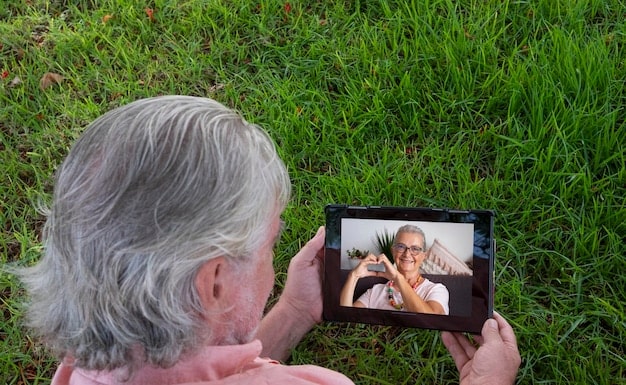Telehealth for Rural Healthcare: Bridging the Access Gap

Telehealth for rural healthcare addresses geographical barriers by providing remote access to specialists, improving healthcare outcomes, and reducing costs for patients in underserved areas.
Access to healthcare specialists can be a significant challenge for individuals living in rural areas. Telehealth for rural healthcare: bridging the gap and improving access to specialists offers a promising solution by leveraging technology to connect patients with healthcare providers remotely, no matter where they are.
Understanding the Challenges of Rural Healthcare
Rural healthcare faces numerous obstacles that contribute to disparities in access and quality of care. These challenges include geographical isolation, limited number of healthcare providers, and inadequate infrastructure.
Geographical Barriers and Limited Access
The vast distances between rural communities and healthcare facilities often make it difficult for patients to receive timely medical attention. This is particularly true for those who require specialized care, as specialists tend to be concentrated in urban centers.
Shortage of Healthcare Professionals
Rural areas often struggle to attract and retain healthcare professionals, leading to a shortage of doctors, nurses, and other medical staff. This scarcity of providers can result in longer wait times, reduced access to services, and a lower standard of care.

To better illustate the challenges, let’s look deeper into key issues:
- Limited specialists available in rural areas.
- Transportation difficulties and costs for patients.
- Delays in receiving necessary medical care.
- Higher rates of chronic diseases due to lack of preventive care.
Addressing these challenges is crucial for improving healthcare outcomes and ensuring that rural residents have access to the same level of care as their urban counterparts. Telehealth offers a viable solution to overcome these obstacles and create a more equitable healthcare system.
The Role of Telehealth in Bridging the Gap
Telehealth plays a vital role in overcoming the barriers to healthcare access in rural areas. By using technology to deliver healthcare services remotely, telehealth can connect patients with specialists, improve chronic disease management, and enhance overall healthcare outcomes.
Remote Consultations and Monitoring
Telehealth enables patients to consult with specialists from the comfort of their own homes, eliminating the need for long and expensive trips to urban centers. Remote monitoring devices can also be used to track vital signs and other health metrics, allowing providers to intervene early when necessary.
Expanding Access to Specialists
One of the most significant benefits of telehealth is its ability to expand access to specialized care. Patients in rural areas can consult with cardiologists, dermatologists, and other specialists without having to travel long distances, ensuring they receive the timely and appropriate care they need.
Key actions of Telehealth in action:
- Virtual appointments with specialists.
- Remote monitoring of chronic conditions.
- Telepharmacy services for medication management.
- Mental health counseling and support.
Telehealth is not a replacement for traditional healthcare but rather a complement to it. It allows healthcare providers to extend their reach and provide care to patients who would otherwise have limited access. By leveraging technology, telehealth can help bridge the gap in rural healthcare and improve the health and well-being of rural communities.
Benefits of Telehealth for Rural Communities
The implementation of telehealth in rural communities provides numerous benefits, ranging from improved access to specialists to reduced healthcare costs. Additionally, telehealth enhances patient outcomes and contributes to a more efficient healthcare system.
Improved Access to Specialists
Telehealth provides rural patients with access to a wider range of specialists, regardless of their location. This is particularly important for those with chronic conditions or those who require specialized care that is not available in their local area.
Reduced Healthcare Costs
Telehealth can significantly reduce healthcare costs for both patients and providers. Patients save money on transportation, lodging, and time off work, while providers can reduce their overhead costs by providing care remotely.

Telehealth also promotes:
- Better management of chronic diseases.
- Increased patient satisfaction and engagement.
- Enhanced coordination of care among providers.
- Reduced hospital readmission rates.
By addressing the unique challenges of rural healthcare, telehealth helps to improve quality of life and promote health equity. The benefits of telehealth extend beyond individual patients and contribute to the overall well-being of rural communities.
Implementing Telehealth Programs in Rural Settings
Successful implementation of telehealth programs in rural settings requires careful planning, collaboration, and investment. It is essential to address issues such as infrastructure limitations, digital literacy, and regulatory barriers.
Infrastructure and Technology Considerations
Reliable internet access and appropriate technology are essential for the success of telehealth programs. Rural communities often lack the necessary infrastructure to support telehealth, so it is crucial to invest in broadband expansion and provide access to devices and software for both patients and providers.
Training and Support for Providers and Patients
Healthcare providers and patients need to be trained on how to use telehealth technologies effectively. This includes training on how to conduct virtual consultations, use remote monitoring devices, and troubleshoot technical issues. Ongoing support is also essential to ensure that both providers and patients feel comfortable and confident using telehealth.
Key aspects include:
- Partnerships with local healthcare organizations.
- Community outreach and education.
- Financial incentives for telehealth adoption.
- Policy changes to support telehealth services.
By addressing these challenges, rural communities can create sustainable telehealth programs that improve healthcare access and outcomes. The successful implementation of telehealth requires a collaborative effort involving healthcare providers, policymakers, technology companies, and community stakeholders.
Overcoming Barriers to Telehealth Adoption
Despite its potential, telehealth adoption in rural areas faces several barriers that need to be addressed. These barriers include regulatory restrictions, reimbursement challenges, and lack of awareness among providers and patients.
Regulatory and Reimbursement Challenges
Telehealth regulations vary by state, creating confusion and limiting the ability of providers to offer telehealth services across state lines. Reimbursement policies also need to be updated to ensure that telehealth services are adequately compensated, encouraging more providers to adopt telehealth.
Lack of Awareness and Acceptance
Some healthcare providers and patients are still not aware of the benefits of telehealth or may be hesitant to adopt it. Overcoming this lack of awareness requires education and outreach efforts to highlight the advantages of telehealth and demonstrate its effectiveness.
Telehealth adoption also needs:
- Advocacy for supportive telehealth policies.
- Development of best practices and standards.
- Collaboration between healthcare systems and technology vendors.
- Patient-centered design of telehealth programs.
By addressing these barriers, telehealth can become a more widespread and accepted part of rural healthcare. Overcoming these challenges is essential to fully realize the potential of telehealth to improve healthcare access and outcomes in rural communities.
The Future of Telehealth in Rural Healthcare
The future of telehealth in rural healthcare is promising, with ongoing advancements in technology and increasing acceptance among providers and patients. As telehealth becomes more integrated into the healthcare system, it has the potential to transform the way care is delivered in rural areas.
Emerging Technologies and Innovations
New technologies, such as artificial intelligence (AI) and virtual reality (VR), are being integrated into telehealth to enhance its capabilities and improve patient outcomes. AI can be used to analyze patient data and provide personalized recommendations, while VR can be used for remote rehabilitation and therapy.
Integration with Traditional Healthcare
Telehealth is becoming more integrated with traditional healthcare, with providers using telehealth to complement in-person visits and provide more comprehensive care. This integration allows providers to seamlessly transition between virtual and in-person care, ensuring that patients receive the right care at the right time.
Telehealth will also provide:
- Expansion of telehealth services to more specialties
- Increased use of remote monitoring devices.
- Greater emphasis on preventive care and wellness.
- Improved access to mental health services.
By embracing new technologies and integrating telehealth into their practices, healthcare providers can improve the health and well-being of rural communities. The future of telehealth in rural healthcare is bright, with the potential to transform the way care is delivered and improve health outcomes for millions of rural residents.
| Key Point | Brief Description |
|---|---|
| 🌍 Overcoming Distance | Telehealth helps rural patients access specialists without long travels. |
| 🧑⚕️ Specialist Access | Telehealth provides access to specialists, important for chronic disease management. |
| 💰 Cost Savings | Reduces costs for rural patients by cutting travel and accommodation expenses. |
| 💻 Technology | Requires adequate internet and tech for virtual visits & remote monitoring. |
FAQ
▼
Telehealth involves using digital tools like video calls and apps to provide healthcare remotely. It connects patients with doctors for consultations, monitoring, and treatment from their homes.
▼
Telehealth improves access by eliminating the need for long trips to see specialists. Rural residents can consult healthcare providers without leaving their communities, facilitating better and timelier care.
▼
Advantages include convenience, reduced travel time and costs, quicker access to specialists, and the ability to monitor health conditions remotely. It also enhances healthcare during public health crises.
▼
Patients typically need a smartphone, tablet, or computer with internet access and a camera. Some telehealth programs may also require specific apps or wearable devices for monitoring vital signs.
▼
Many insurance plans now cover telehealth services, but coverage can vary. It’s best to check with your insurance provider to understand what telehealth services are covered under your plan.
Conclusion
Telehealth for rural healthcare: bridging the gap and improving access to specialists is not just a technological advancement; it’s a lifeline for countless individuals in underserved communities. By addressing geographical barriers, reducing healthcare costs, and enhancing patient outcomes, telehealth stands as a pivotal solution for creating a more equitable and accessible healthcare system for all Americans.





